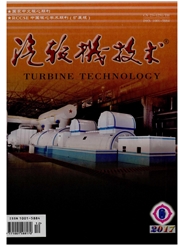

 中文摘要:
中文摘要:
基于厚壁带肋通道蒸汽冷却实验数据,发展了含有内热源项的耦合传热计算方法,研究了雷诺数、热流密度和湍流度对厚壁矩形带肋通道内蒸汽流动及传热特性的影响,同时对比了耦合传热方法和只计算流体域方法之间的差异,并在此基础上对努塞尔数与雷诺数、热流密度和湍流度之间进行数值拟合,得到了厚壁带肋通道的传热关联式。研究结果表明:含有内热源项的耦合传热计算模型可以准确地模拟厚壁带肋通道内蒸汽的流动与传热特性,只计算流体域模型对传热系数的预测较耦合传热模型低10%;热流密度对厚壁带肋通道蒸汽摩擦和传热特性的影响较小,高热流密度使得壁面传热效果变差;雷诺数从10 000~90 000变化时,平均传热系数和综合传热因子分别提高了76%和63%,而湍流度从3%~15%变化时,平均传热系数提高了大约24%,综合传热因子提高了19.8%。该研究可为未来重型燃机叶片冷却结构设计提供参考。
 英文摘要:
英文摘要:
Based on the experimental data of a steam cooled thick-wall ribbed channel, a conjugate calculation model was established to investigate the influences of Re, heat flux and turbulence intensity on the flow and heat transfer performance of the thick-wall ribbed channel. The difference between the conjugate calculation model and the general iso-heat-flux model was also analyzed. Then the relationship of Nu with Re, heat flux and turbulence intensity was deduced and developed. The results indicate that the conjugate calculation model is able to accurately predict the flow and heat transfer characteristics of the thick-wall ribbed channel, and the local heat transfer coefficients predicted by the general iso-heat-flux model are about 10% lower than that of the conjugate calculation method. Heat transfer performance of the steam-cooled ribbed channel with 313 heat conduction effect decreases with the increasing wall heat flux. The heat transfer coefficients and the thermal enhancement factors of the thick-wall ribbed channel heighten by 76% and 63% respectively as _Re varies from 10 000 to 90 000, and increase by 24% and 19.8% respectively as the turbulence intensity varies from 3% to 15%.
 同期刊论文项目
同期刊论文项目
 同项目期刊论文
同项目期刊论文
 Experimental study on cooling performance of a steam-cooled turbine blade with five internal cooling
Experimental study on cooling performance of a steam-cooled turbine blade with five internal cooling An experimental research on the cooling performance of the turbine vane with an advanced duplex-medi
An experimental research on the cooling performance of the turbine vane with an advanced duplex-medi 期刊信息
期刊信息
